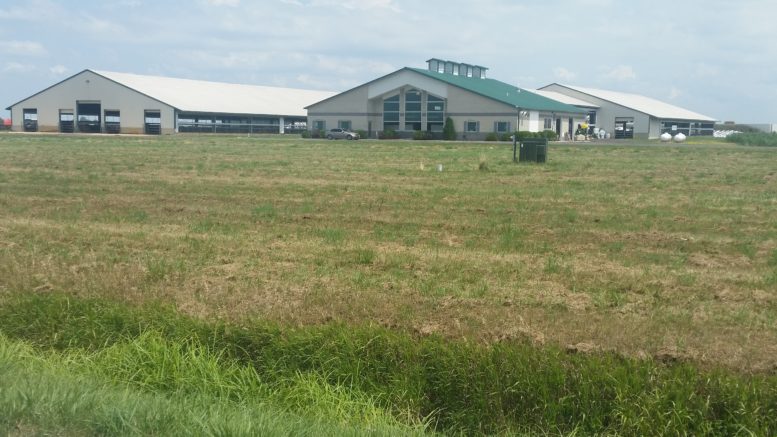By JAN LARSON McLAUGHLIN
BG Independent News
Milk does a body good. No one is disputing that. It’s the byproduct of the dairy cows that local officials are questioning.
Last week, the Wood County Commissioners heard from three people about problems associated with Concentrated Animal Feeding Operations in the county. Those concerns included a full manure lagoon left behind when a large dairy went bankrupt, the damage caused on rural roads not built to handle mega dairy traffic, and the impact on Lake Erie when the manure reaches the lake and fuels algal blooms.
Vickie Askins informed the commissioners that when the Manders Dairy went bankrupt about four years ago, it left behind about 10 million gallons of manure it its lagoon. Since then, about one million gallons have been trucked to the Campbell Soup plant and run through its digesters.
That leaves about 9 million gallons of manure behind at the dairy, located at the corner of Rangeline and Maplewood roads, southwest of Bowling Green.
“It’s been sitting there basically full,” Askins said.
Federal law requires that the manure must be taken care of when a CAFO closes, Askins said. And Ohio EPA requires that no manure be applied to farm fields unless up-to-date soil samples and manure analyses are obtained.
Askins, a self-motivated watchdog of mega dairies in Wood County, said neither has been done. The lagoon is nearly full, and no field application study documentation can be found. Yet, she has seen evidence of “manure irrigators” being constructed near the site.
“Wait a minute,” she said. “No manure shall be applied till you have a valid plan.”
Southeast of Bowling Green, another large dairy is causing headaches for Portage Township Trustee Dave Housholder. That dairy, at the corner of Portage and Bloomdale roads, recently received a permit to expand to 2,960 cows, Askins said.
The township is already struggling to keep up with the wear and tear on the roads near the dairy, Housholder told the county commissioners. An expansion will create even more financial hardship for Portage Township, he said.
And further to the north, it’s the impact of the manure on the health of Lake Erie that has Mike Ferner concerned. Ferner talked to the commissioners about the effort by the Advocates for a Clean Lake Erie to have the Western Lake Erie Basin officially declared “impaired.”
“Our goal is to return Lake Erie to a drinkable, fishable, swimmable body of water,” the advocates’ material states.
The clean water advocates point to the algal blooms in 2014, which caused Toledo to warn nearly 500,000 people not to drink the city’s water which comes from Lake Erie. The Maumee River drains 6,608 square miles in Ohio, Michigan and Indiana. According to the Sierra Club, more than 700 million gallons of manure are spread on fields draining into the Western Basin of Lake Erie just from the 146 registered Concentrated Animal Feeding Operations.
Ferner’s information stated the single largest source of the phosphorus that generates the harmful algal blooms is manure from CAFOs. The Maumee River acts as a pipeline for that phosphorus into Lake Erie.
The Lucas County Commissioners have reportedly signed the group’s request that the basin have a “designation of impairment.” The Wood County Commissioners told Ferner last week that they would study the issue and make a decision.
Wood County Administrator Andrew Kalmar said the “impaired” designation would trigger a full-scale investigation of all possible sources of pollution going into the lake, and then require action to reduce that contamination.
Askins said if the manure from the former Manders Dairy is allowed to be spread on farm fields, it would become part of the problem. “This will reach Lake Erie,” she said.
Askins has written a letter voicing her concerns to the Ohio Environmental Protection Agency. Kalmar said since the CAFOs are monitored by the state, there is little the county can do other than be supportive of Askins’ efforts.
“There’s nothing really the commissioners can do, other than advocate on their behalf,” Kalmar said.
And as far as the road maintenance concerns, Kalmar said Housholder was asked to get detailed numbers together for the commissioners. That information can then be presented to state legislators in an effort to get requirements in place forcing CAFOs to help share in the road repair expenses.

